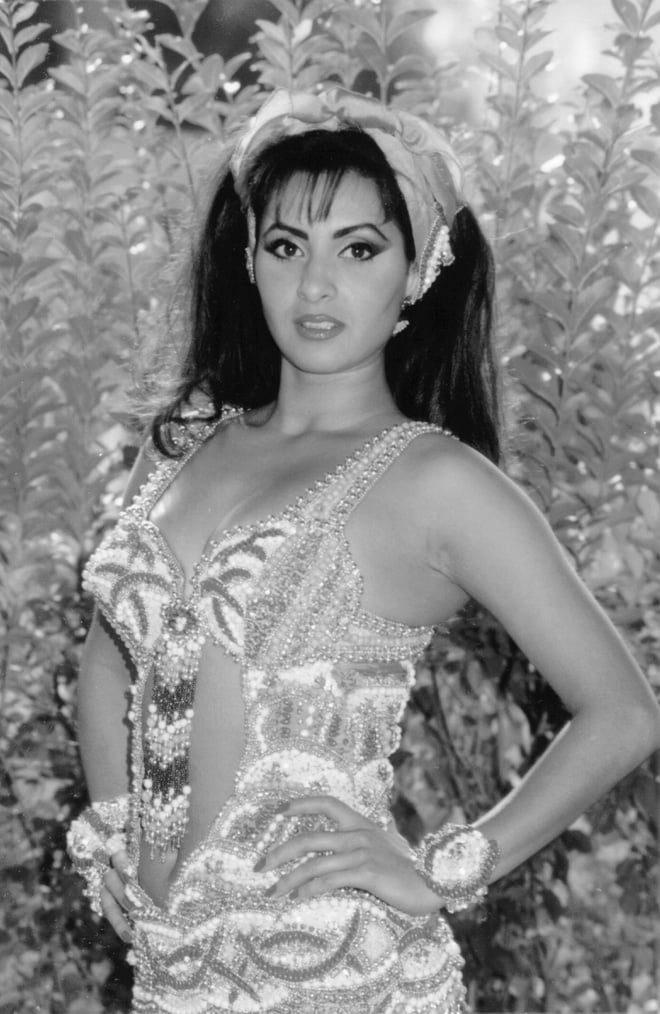Lebanon’s Dancing Queens: Celebrating Belly Dancers From the 80s and 90s
Back in the 80s and 90s, Beirut’s nightlife pulsed with live music, glittering hotel shows, and stages filled with some of the region’s most talented belly dancers.
The dancers of this era in Lebanon weren’t just entertainers. At a time when the country was rebuilding after the civil war, they elevated this style of dance from hotel shows to theatrical productions, adding narrative, costume, and creative flair.
While belly dance has long roots in the Middle East, these dancers elevated it in Lebanon by adding theatricality, storytelling, and fusion styles.
Here are some of Lebanon’s most iconic belly dancers
Amani
Born Angel Nabil Ayoub in 1970 in the village of Hamat in North Lebanon, her family gave her the stage name “Amani” when she chose to pursue Oriental dance professionally.

She kickstarted her career in 1987, and though the Lebanese civil war was ongoing, she travelled abroad for performances in the Gulf, Europe, Australia, and more.
She’s often credited for establishing a new approach to dance in Lebanon involving theatrical shows, immersive storytelling, and costume changes. She elevated the scene from beyond simple shows to full-blown performances.
Amani helped shift Oriental dance in Lebanon out of the club/hotel circuit into more staged theatrical formats.
Dany Bustros
Born into the prominent Bustros family in 1959, Dany Bustros became known as Lebanon’s leading belly dancing, combining traditional belly dance with Western influences like flamenco and modern dance.
She performed in high‑profile productions such as Boulevard de la Cité (1991) and eventually transitioned to stage acting as well. Bustros brought an elevated, theatrical element to belly dance in Lebanon. Her performances helped show the artistic depth and versatility of belly dancing to wider audiences.

Unfortunately, she died by suicide in 1998. She is often brought up in discussions about the pressures on performance artists and mental health in Lebanon’s entertainment industry.
Samara
The Iraqi-born belly dancer moved to Lebanon in 1981 and studied under the legendary Egyptian dancer Nadia Gamal, who told her to develop her own signature style rather than simply copy other dancers.

She became very active in the mid‑80s to early 2000s. Samara was known for her dramatic stage shows and themed productions, drum solos, and fusion elements. She often incorporated influences from Indian, Polynesian and New‑Age styles.
She managed her own band at times and brought large‑scale productions to Lebanese hotels and international venues. Samara’s innovation in show format and her high visibility made her a major figure in Lebanese Oriental dance. She earned the nickname “Sayyida Raqs Sharqi” in the Lebanese press.
Her career also illustrates the crossover between Lebanese night‑life, hotel shows, and pan‑Arab entertainment circuits in the 80s and 90s.
Howaida El Hachem
Howaida El Hachem emerged in the Lebanese dance scene in the late‑1980s and 1990s.
She became known for high‑energy performances, often featured on Lebanese television during that era. Her style stood out for her strong technicality and stage presence during a time when hotel shows and TV appearances were prominent for belly dance in Lebanon.
After the 1990s, she quietly faded from the stage.
Nariman Abboud
Nariman Abboud was a celebrated Lebanese belly dancer who rose to prominence in the 1990s. Early in her career, she caught the attention of singer Melhem Barakat, which helped her break into Lebanon’s entertainment circuit.
She performed on television game shows, outdoor concerts in Beirut, and appeared on recorded dance albums, such as Nariman 1995 – Belly Dance.
Abboud represents the generation of dancers who bridged television, hotel shows, and music recordings, helping to shape Lebanon’s dance culture in the 90s. She later married singer Wissam El Amir and gradually stepped back from public performances in the early 2000s.
Abboud sadly passed away in 2021 due to COVID-19.
Dina Jamal
Dina Jamal was part of Lebanon’s vibrant 80s and 90s dance scene, performing in hotel shows, television appearances, and local nightclubs.
While detailed records of her biography and career are scarce, she represents the many talented dancers who helped shape the Lebanese style of Oriental dance during this era.
Her performances contributed to the theatrical and stylistic evolution of raqs sharqi in Beirut, adding energy, flair, and presence to stages across the city.
Jamal’s work reflects the rich tapestry of dancers who defined a generation of Lebanese performance culture.
Rindala
Rindala was one of the many dancers who lit up Beirut’s stages in the 80s and 90s. While specific details about her career are limited, she performed in hotel shows, nightclubs, and likely television appearances, contributing to the city’s lively entertainment scene.
Like many performers of the era, Rindala helped shape the Lebanese interpretation of Oriental dance, blending traditional techniques with theatrical flair for live audiences.
Her work reflects the breadth of talent that made Beirut a hub for music and dance during this period.
Did we miss any of Lebanon’s most iconic belly dancers during that era? Let us know!






